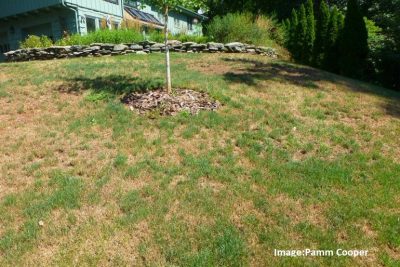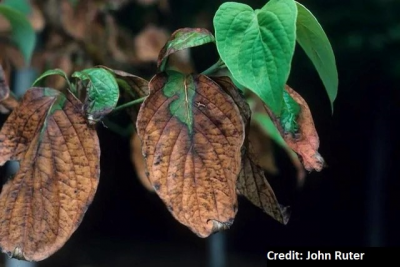By Pamm Cooper, UConn Home & Garden Education Center

Here at the UConn Home and Garden Center we have been getting questions about lawn and garden issues that have been particularly widespread in the state. Whether in the landscape or the garden, there is always something going on, good or bad, and keeping up with pests or cultural issues can be challenging. Because of the extended late season drought conditions this year, plants may be showing signs of stress. There are some basic things homeowners can do to help plants go into winter as healthy as possible.
Plants in temperate climates, like we have in New England, are normally manufacturing food to enable carbohydrate storage for new growth that will occur next spring. To do this, plants need both sunlight and water, and our extended drought conditions have limited most plants to enter survival mode, and carb storage is a second priority. The best way to help your plants is to water deeply any that still have green leaves. People with wells may need to determine if this is a priority for them. We can hope for a warm winter or insulating snow cover to help any plants with shallow roots survive until warm weather returns.

One sign of drought stress in woody broadleaf plants is leaf edges that curl upward. This is a good clue as to the beginning of water stress. Make sure to water these plants deeply, to ensure roots will be able to pick up the water. Usually the next day, leaves will start to uncurl if adequate water is applied. If drought stress continues, leaves may turn brown at the edges and early leaf drop may occur.
Evergreens, even established ones, can benefit from regular watering as long as the soil is not frozen and drought conditions remain. Evergreen foliage, whether needles or leaves, photosynthesize all year, and it is important that soil is not dry. Normally, we have snow that melts on and off, and if soils are not frozen, roots will be able to take up water and photosynthesis can still take place.
Perennials of certain species may be doing fine in this drought. Yarrows, some ox-eyed daisy cultivars, obedient plants, goldenrods, mountain mints and Agastache may be showing no signs of stress. Still, if any have green leaves at this point, consider watering them if dry and warm conditions continue.
This weekend I planted a small shrub, and I had to dig about fourteen inches down to accommodate the root mass. I have to say that I was surprised that the soil, not particularly one that dries out often, was powdery to the bottom of the hole. If you are planting anything now, make sure to water the soil thoroughly as you fill in the area around the roots, then water again when done. This is especially needed for small trees and shrubs but do the same for perennials.
Next year, woody plants that were impacted by drought this year may be more susceptible to certain diseases like verticillium wilt, Nectria canker and evergreens to Rhizosphaera needlecast. Be vigilant and scout for any signs or symptoms of these diseases.
Lawns that did not receive any rainfall or supplemental watering during the past two months may be dormant and crunchy at this time. It may not be clear if the grass will recover when temperatures cool and adequate water is applied. Some grass species may be dead, but it may not be clear until next spring when they fail to green up. There still may be time to apply supplemental irrigation, and with warm temperatures, grass may or may not green up, but at least the crowns may be kept alive to generate new leaves next spring. If any lawn areas were seeded in late summer, water new grass as needed. If it is wilting, water it for sure.
Be alert to what is happening in your own backyard, for the sooner you discover any problems the better. Contact us at the University of Connecticut Home and Garden Education Center for advice on lawns, landscapes, and other gardening subjects. Here's hoping for some needed rainfall and cooler temperatures to help our plants recover from the trying drought of 2024.
Penn State Extension has a good article on long-term effects of drought stress- https://extension.psu.edu/the-long-term-impact-of-drought-on-trees-and-shrubs
If you have questions about caring for plants during a drought, or if you have other gardening questions, feel free to contact us, toll-free, at the UConn Home & Garden Education Center at (877) 486-6271, visit our website at www.homegarden.cahnr.uconn.edu or contact your local Cooperative Extension center.